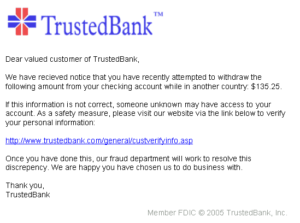Mary is 77 years old, but she is an avid email user and loves to communicate with others. She recently received a message that told her the sender was stranded in at a London airport because someone stole his wallet, which contained all his money, checks and credit cards. Now, he has no way to get home to the United States. The sender continues on that he needs to get back to America soon because his mother is in the hospital with cancer. He asks Mary if she could click the link below where she could put in her credit card to pay for his trip back.
John is 55 years old and not that computer literate. He recently got an email that said a family is in Africa and a military coup just started. They need emergency funds immediately in order to get out of the country. A phone number is listed and asks John to call so that he can help them.
Many of you are probably already used to seeing scams like this, but many are not, as these ‘phishing’ emails are just that – the fish for information and pray on the elderly and anyone else who they can catch.
You will notice that they have many common factors. Besides asking for money (which you should never respond to) are other signs of phishing.
They start off with “Good Day’. How many people in the United States sends an email to others with a greeting such as that? Then the next signal that this is a scam is that they will always pick at the compassion in you by telling you a soap opera that something happened and they will be in dire danger if they don’t get the funds right away.
There are thousands of these types of phishing email scams. Be alert and know that they are nothing by a means to get to you money.
Follow this rule:
IF YOU DON’T KNOW THEM PERSONALLY, DO NOT RESPOND
 Other email scams that try to get to your credit cards or bank accounts come from what looks like a real back and if you have an account with that bank, you may fall for their scams if you do not adhere to the warning signals that are in the messages.
Other email scams that try to get to your credit cards or bank accounts come from what looks like a real back and if you have an account with that bank, you may fall for their scams if you do not adhere to the warning signals that are in the messages.
Some examples would be an email which says that it is from Citibank, Discover Card, Paypal or possibly even a government agency. The message would state that you need to “update” or “validate” your account information.
It then supplies a link that will direct you to a website that looks just like the legitimate organization’s website, but it isn’t. The purpose of this bogus site (which is called spoofing) is to trick you into divulging your personal information, so they can steal your identity and commit crimes in your name.
Here is an example that scammers use:
Good afternoon, unfortunately some processings have been cracked by hackers, so a new secure code to protect your data has been introduced by Visa. You should check your card balance and in case of suspicious transactions immediately contact your card issuing bank. If you don’t see any suspicious transactions, it doesn’t mean that the card is not lost and cannot be used. Probably, your card issuers have not updated information yet. That is why we strongly recommend you to visit our website and update your profile, otherwise we cannot guarantee stolen money repayment. Thank you for your attention. Click here and update your profile.
For more information on phishing and how to reduce your security risks, you can go to:
- paypal.com, click Free Alerts to Help Protect You From ID Theft (bottom right), Click Identity Theft Guide (bottom center), Click Phishing Guide (bottom of page).
And remember:
 What Makes Me Different From the Others?
What Makes Me Different From the Others?